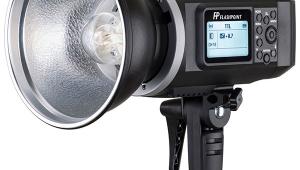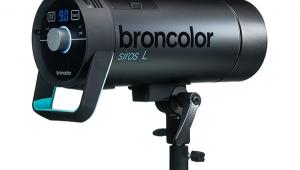Litepanels MicroPro Hybrid: Flash And Constant Light Sources In One Unit
The Litepanels MicroPro Hybrid does double duty as both a constant light source and a flash. The light itself is made of black plastic and is fairly small, at 5.5x3.75x1.5”, and weighs only about a pound when you include the mounting bracket and six AA batteries (standard or rechargeable, and there is an optional AC adapter available). The top has a knurled knob to turn things on and acts as a dimmer so you can control output in stepless fashion. Vents are located around all sides. The battery door, flash ready light, flash sync, and input for the optional power adapter are all located on the back. The bottom is threaded so you can attach it to a light stand or to the (included) nicely made aluminum ball joint with a bottom end that slides into your camera’s shoe mount. Also included is a very short PC cord to be used when using the flash mode, plus there are warming, diffusion, and tungsten conversion filters that snap in easily over the front panel. All this fits into a nicely padded zippered bag.


Courtesy of Litepanels
Nice kit, and now that we’ve seen what you get, just what are we going to use it for? The company touts this light as a “perfect complement” to those shooting video with their D-SLRs. Litepanels has always been a player in the video world, so the hybrid in the name pretty much adapts the product to how some folks use their D-SLRs—as still and motion recording devices, thus the constant, flicker-free, daylight-balanced light source plus the added kick of a low-powered flash unit.


All Photos © Steve Bedell
There’s a maxim in photography that goes something like this: “You can control low light; you have to deal with bright light.” That’s what I think this light is all about. Forget using it in the sun or bright light; it doesn’t have enough juice. But in low-light levels, like in a hotel lobby or reception hall at a wedding, you can use this to add sparkle to your images, fill in deep shadows, or even use it as the main source of light, provided you are close enough. You can use it to dial in just the right amount of shadow detail in those window light portraits, or shoot some video in the cave also known as the reception hall, and then pop off some still photos using the flash. That constant light also makes it much easier for your camera to focus before kicking in with the flash.
To give you an idea of just how much output we’re talking about here, I metered the constant light at 1/60 sec at f/4 at ISO 400 at 3 feet. At that same 3 feet I popped off the flash and got f/5.6. Given these numbers, you can see the light is designed for close distances, higher ISO settings, or some combination of the two. So when using this light keep close to your subject so the light is powerful enough to matter and don’t go too wide since the beam from the light is pretty narrow and drops off quickly.


I shot some short videos using a Canon EOS 7D in my studio waiting area where there is a mix of tungsten and daylight. Shooting at about 4 feet from my subject I was able to overpower the room light slightly and shoot with a daylight color balance while most of the background was quite warm from the tungsten light.
In still shooting, I used the light in a variety of ways, either by itself or in combination with other lights. Most portraits today are done using large light sources for a soft, even light with a gradual transition to the shadows. This light is not made for that, so instead of trying to make it do something it’s not designed for, I decided to embrace it and create portraits with the small, well-defined light source it provides. I had fun creating images with a little different look to them and it’s never a bad thing to snap out of your comfort zone every once in a while. I also used the light directly on the camera as the main light source with flash and as fill light using its constant light. Like they say, it’s a hybrid.

We are now living in a world where the distinction between a still and video camera is blurring, so this hybrid approach can make sense for the D-SLR photographer who shoots an occasional video or the video photographer who shoots occasional stills. At a street price of about $475 it’s not for the amateur. But once you get your hands on one and shoot a few jobs with it, it might become a permanent part of your kit.

For more information, contact Litepanels at: www.litepanels.com.

















































